- Road lanes designated for use by bicyclists and vehicles are called shared use lanes. They can be installed in several locations:
- Bicycle boulevards
- Traffic calmed streets with design speeds < 25 mph
- On downhill segments
- Within single or multilane roundabouts
- Along front-in angled parking
- Where streets are only wide enough to accommodate a dedicated bike lane in one direction
- Sharrows are typically applied to road surfaces to indicate the shared lane environment and facilitate proper bicyclist positioning. Table 29.3 reviews guidelines for shared use lanes.
| Table 29.3 Design Guidelines for Shared Use Lanes | |
| Design Element | Guideline |
| Lane Widths |
|
| Signs |
|
| Markings |
|
- If a road is wide enough to accommodate separated bicycle lanes, they are a better option than shared use lanes because they create fewer traffic impacts and result in a safer road environment.
CONTACT:
Chris VanDyke
Research Scientist | Program Manager
chrisvandyke@uky.edu


